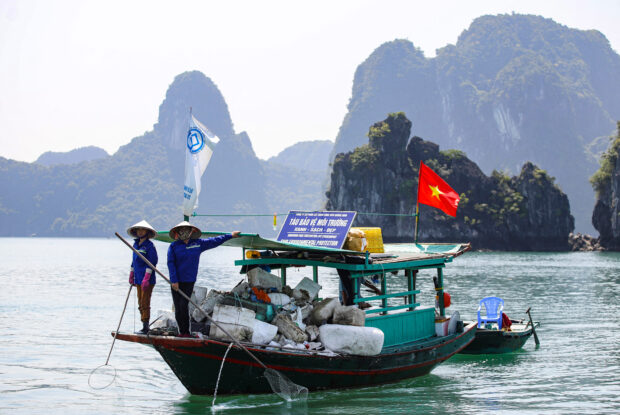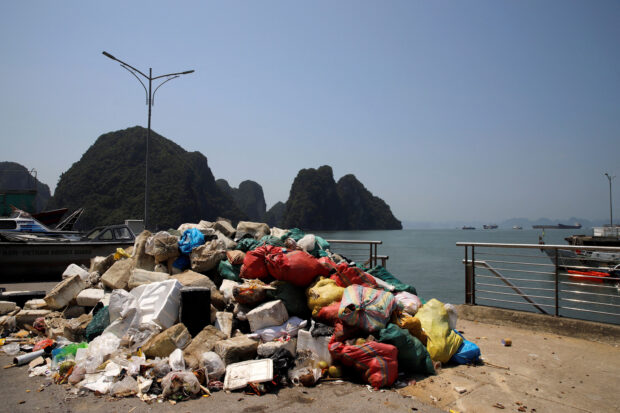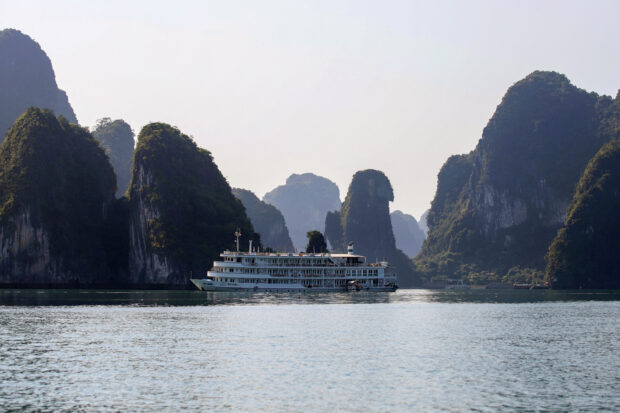Vietnam battles plastic blight in idyllic Ha Long Bay

This photo taken on May 17, 2023, shows workers on a boat picking up foam buoys in Ha Long Bay in northeast Vietnam. More than seven million visitors came to visit the spectacular limestone karsts of Ha Long Bay, on Vietnam’s northeastern coast, in 2022. Authorities hope that number will jump to eight and a half million this year. But the site’s popularity, and the subsequent rapid growth of Ha Long City – which is now home to a cable car, amusement park, luxury hotels, and thousands of new homes – severely damaged the ecosystem of the water. Photo by Nam NGUYEN / AFP
HA LONG, Vietnam — Squinting in the bright light of a hot summer morning, Vu Thi Thinh perches on the edge of her small wooden boat and plucks a polystyrene block from the calm waters of Vietnam’s Ha Long Bay.
It’s not yet 9 a.m., but a mound of styrofoam buoys, plastic bottles, and beer cans sit behind her.
They are the most visible sign of the human impacts that have degraded the UNESCO World Heritage Site, famed for its brilliant turquoise waters dotted with towering rainforest-topped limestone islands.
“I feel very tired because I collect trash on the bay all day without much rest,” said Thinh, 50, who has been working for close to a decade as a trash picker.
“I have to make five to seven trips on the boat every day to collect it all.”
Since the beginning of March, 10,000 cubic meters of rubbish – enough to fill four Olympic swimming pools – have been collected from the water, according to the Ha Long Bay management board.
READ: Rise in ocean plastic pollution ‘unprecedented’ since 2005
The trash problem has been particularly acute over the past two months, as a scheme to replace styrofoam buoys at fish farms with more sustainable alternatives backfired and fishermen chucked their redundant polystyrene into the sea.
Authorities ordered 20 barges, eight boats, and a team of dozens of people to launch a clean-up, state media said.
Do Tien Thanh, a conservationist at the Ha Long Bay Management Department, said the buoys were a short-term issue but admitted: “Ha Long Bay… is under pressure.”

This photo taken on May 17, 2023, shows a pile of trash collected from Ha Long Bay in northeast Vietnam. More than seven million visitors came to visit the spectacular limestone karsts of Ha Long Bay, on Vietnam’s northeastern coast, in 2022. Authorities hope that number will jump to eight and a half million this year. But the site’s popularity, and the subsequent rapid growth of Ha Long City – which is now home to a cable car, amusement park, luxury hotels and thousands of new homes – severely damaged the ecosystem of the water. Photo by Nam NGUYEN / AFP
Human waste
More than 7 million visitors came to visit the spectacular limestone karsts of Ha Long Bay, on Vietnam’s northeastern coast, in 2022.
Authorities hope that number will jump to eight and a half million this year.
But the site’s popularity, and the subsequent rapid growth of Ha Long City – which is now home to a cable car, amusement park, luxury hotels and thousands of new homes – have severely damaged its ecosystem.
READ: Earth Day 2023: PH advocates tackle reclamation, plastic waste
Conservationists estimate there were originally around 234 types of coral in the bay – now the number is around half.
There have been signs of recovery in the past decade, with coral coverage slowly increasing again and dolphins – pushed out of the bay a decade ago – coming back in small numbers, as a ban on fishing in the core parts of the heritage site expanded their food source.
But the waste, both plastic and human, is still a huge concern.
“There are so many big residential areas near Ha Long Bay,” said conservationist Thanh.
“The domestic waste from these areas, if not dealt with properly, greatly impacts the ecological system, which includes the coral reefs.
“Ha Long City can now handle just over 40 percent of its wastewater.”
Single-use plastic is now banned on tourist boats, and the Ha Long Bay management board says general plastic use on board is down 90 percent from its peak.
READ: Plastic waste from hospitals: An emergency case
But trash generated onshore still lines parts of the beach, with a team of rubbish collectors not able to block the eyesore from tourists.

This photo taken on May 17, 2023, shows a tourist boat next to karst formations in Ha Long Bay in northeast Vietnam. More than seven million visitors came to visit the spectacular limestone karsts of Ha Long Bay, on Vietnam’s northeastern coast, in 2022. Authorities hope that number will jump to eight and a half million this year. But the site’s popularity, and the subsequent rapid growth of Ha Long City – which is now home to a cable car, amusement park, luxury hotels and thousands of new homes – severely damaged the ecosystem of the water. Photo by Nam NGUYEN / AFP
‘Plastic pollution crisis’
Pham Van Tu, a local resident and freelance tour guide, said he had received a lot of complaints from visitors.
“They read in the media that Ha Long Bay is beautiful, but when they saw a lot of floating trash, they didn’t want to swim or go canoeing and they hesitated to tell their friends and family to visit,” he said.
Rapid economic growth, urbanization and changing lifestyles in communist Vietnam have led to a “plastic pollution crisis,” according to the World Bank.
A report in 2022 estimated 3.1 million tonnes of plastic waste are generated every year, with at least 10 percent leaking into the waterways, making Vietnam one of the top five plastic polluters of the world’s oceans.
READ: Microplastics in Metro Manila air alarm scientists
The volume of leakage could more than double by 2030, the World Bank warns.
Larissa Helfer, 21, who traveled to Vietnam from her home in Germany, said Ha Long Bay was beautiful but the trash problem would be one of her strongest memories of the trip.
“Normally you (might say) ‘Look at the view! Look at the fishing villages!” she told AFP.
But here “you have to talk about the trash, (you say) ‘oh god… look at the plastic bottles and things in the sea.’ And it makes you sad.”
Thinh, the trash collector, grew up in Ha Long and remembers a very different bay.
“It didn’t look so terrible,” she said.
“Of course, a lot of work makes me tired and irritated,” she admitted. “But we must do our work.”
READ: A call to action to address the plastic situation














